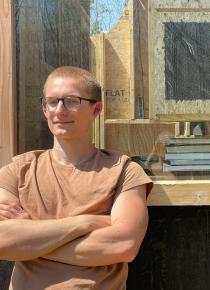Jeremy Huelin

Meet Jeremy Huelin
Hometown: Jackson, TN
College: Architecture, Art, and Planning
Major: Architecture
Year: 2023
Graduating Cornell Tradition Fellow Jeremy Huelin (AAP, Architecture, ’23) is leaving one of Cornell’s neighboring communities a little better than when he arrived on campus just a few years ago.
“As a student, studying intensely, it’s easy to become consumed with your own work. I think part of being human and living a human life day-to-day is going out and serving other people. And so, keeping that on the forefront of your mind as you go through a rigorous academic experience really helps ground you.”
Jeremy is a fifth-year Architecture student from Tennessee, who made his decision to apply to Cornell on a “whim.” Jeremy knew he wanted to study architecture, so pushed by a friend, he conducted an online search for “best architecture schools.” Cornell ranks at the top of the list of results, and without knowing much more than the university had a good architecture program, he applied with no expectations of being accepted. He shared that when he learned he had been admitted that he was honored, and that his Cornell journey has been an amazing experience.
To meet his Tradition work and service requirements, Jeremy spent his first four years working for Dining on North Campus and participated in volunteer opportunities hosted by on-campus Christian organizations like Chesterton House, a center for Christian studies. Through the Chesterton House, Jeremy could work on small daily tasks such as cooking and cleaning in service of a larger community. Relationships in the Christian community provided the opportunity to develop architectural plans for a nearby community project.
Second Wind is a non-profit organization that provides transitional affordable housing for homeless or formerly incarcerated men. There are 18 cottages that are currently operating in the Town of Newfield. Second Wind’s latest construction project is a women’s residence, specifically homeless women with children in the foster care system who are working towards becoming reunited. This shelter is being constructed in the Town of Dryden and should be finalized this summer. Jeremy spent roughly 70 hours designing the architecture of the residence with the intent to save the organization the billable hours that a professional architect would charge in the design development phase. “I created most of the conceptual design for it, which saved them a considerable amount of money in architecture fees. It’s just a great thing because the project in general was an opportunity to apply my design to something that will impact the local community.” The construction of the shelter relies entirely on volunteer labor, so Jeremy has visited the site to help with the build, which has also allowed him to meet and speak with other volunteers in the area. “I’m building what I designed, which is a really informative experience, especially at this age as an architect.”
Jeremy’s thesis is concerned with this very dichotomy. As he wraps up his final semester at Cornell, he is completing his thesis project, which is based on living with the consequences of his own design. By constructing a generic uninsulated cube as a blank canvas and moving in when it was all but unlivable, he and his partner are attempting to propose a new method of architectural learning that compresses the timeline of designing, building, and living into a single moment. After graduation, he will be returning to Tennessee to work for Hord Architects, a firm that builds traditional churches, as well as schools and other public projects across the United States.
